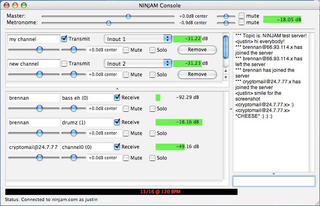
In computing, a plug-in is a software component that adds a specific feature to an existing computer program. When a program supports plug-ins, it enables customization.
Justin Frankel is an American computer programmer best known for his work on the Winamp media player application and for inventing the Gnutella peer-to-peer network. Frankel is also the founder of Cockos Incorporated, which creates music production and development software such as the REAPER digital audio workstation, the NINJAM collaborative music tool and the Jesusonic expandable effects processor. In 2002, he was named in the MIT Technology Review TR100 as one of the top 100 innovators in the world under the age of 35.

Winamp is a media player for Microsoft Windows originally developed by Justin Frankel and Dmitry Boldyrev by their company Nullsoft, which they later sold to AOL in 1999 for $80 million. It was then acquired by Radionomy in 2014. Since version 2 it has been sold as freemium and supports extensibility with plug-ins and skins, and features music visualization, playlist and a media library, supported by a large online community.

Nullsoft, Inc. was an American software house founded in Sedona, Arizona, in 1997 by Justin Frankel. Its products included the Winamp media player and the SHOUTcast MP3 streaming media server. In later years, their open source installer system, the Nullsoft Scriptable Install System (NSIS) became an alternative to commercial products like InstallShield. The company's name is a parody of Microsoft. Mike the Llama is the company's mascot; this is frequently referred to in promotional material citing llamas. Frankel introduced the llama in Winamp's startup sound clip, inspired by the lyrics of Wesley Willis: "Winamp, it really whips the llama's ass!"

Pidgin is a free and open-source multi-platform instant messaging client, based on a library named libpurple that has support for many instant messaging protocols, allowing the user to simultaneously log in to various services from a single application, with a single interface for both popular and obsolete protocols, thus avoiding the hassle of having to deal with a new software for each device and protocol.
foobar2000 is a freeware audio player for Microsoft Windows, iOS and Android developed by Peter Pawłowski. It has a modular design, which provides user flexibility in configuration and customization. Standard "skin" elements can be individually augmented or replaced with different dials and buttons, as well as visualizers such as waveform, oscilloscope, spectrum, spectrogram (waterfall), peak and smoothed VU meters. foobar2000 offers third-party user interface modifications through a software development kit (SDK).
Shoutcast is a service for streaming media over the Internet to media players, using its own cross-platform proprietary software. It allows digital audio content, primarily in MP3 or High-Efficiency Advanced Audio Coding format. The most common use of Shoutcast is for creating or listening to Internet audio broadcasts; however, there are also video streams. The software is available to use for free or as a paid cloud service with additional professional features.
Nullsoft Streaming Video (NSV) was a media container designed for streaming video content over the Internet. NSV was developed by Nullsoft, the makers of Winamp.

Far Manager is an orthodox file manager for Microsoft Windows and is a clone of Norton Commander. Far Manager uses the Win32 console and has a keyboard-oriented user interface.
JRiver Media Center is a multimedia application that allows the user to play and organize various types of media on a computer running Windows, macOS, or Linux operating systems.

NINJAM stands for Novel Intervallic Network Jamming Architecture for Music. The software and systems comprising NINJAM provide a non-realtime mechanism for exchanging audio data across the internet, with a synchronisation mechanism based on musical form. It provides a way for musicians to "jam" (improvise) together over the Internet; it pioneered the concept of "virtual-time" jamming. It was originally developed by Brennan Underwood, Justin Frankel, and Tom Pepper.

MilkDrop is a hardware-accelerated music visualization plugin for Winamp and Kodi, which was originally developed by Ryan Geiss in 2001. It uses DirectX and intelligent beat detection to render iterated images which blend seamlessly. MilkDrop uses a complex system of interpolation to transition between presets gradually through time, creating a constantly changing visual experience.

Music visualization or music visualisation, a feature found in electronic music visualizers and media player software, generates animated imagery based on a piece of music. The imagery is usually generated and rendered in real time and in a way synchronized with the music as it is played.

K-Multimedia Player is an Adware-supported media player for Windows and iOS that can play most current audio and video formats, including VCD, HDML, DVD, AVI, MKV, Ogg, OGM, 3GP, MPEG-1/2/4, AAC, WMA 7, 8, WMV, RealMedia, FLV and QuickTime. KMPlayer shows many advertisements, including in the homepage, side panels, options panel, and as pop-up ads.
The following comparison of audio players compares general and technical information for a number of software media player programs. For the purpose of this comparison, "audio players" are defined as any media player explicitly designed to play audio files, with limited or no support for video playback. Multi-media players designed for video playback, which can also play music, are included under comparison of video player software.
Cockos, Inc is an American digital audio technology company founded in 2004, most notable for their digital audio workstation software REAPER.
OpenFX (OFX), a.k.a. The OFX Image Effect Plug-in API, is an open standard for 2D visual effects or compositing plug-ins. It allows plug-ins written to the standard to work on any application that supports the standard. The OpenFX standard is owned by The Open Effects Association, and it is released under a 'BSD' open source license. OpenFX was originally designed by Bruno Nicoletti at The Foundry Visionmongers.
Radionomy was an online platform that provided tools for operating online radio stations. It was part of Radionomy Group, a company which later acquired the online streaming platform SHOUTcast from Nullsoft, and eventually consolidated Radionomy into its SHOUTcast service.

GPUOpen is a middleware software suite originally developed by AMD's Radeon Technologies Group that offers advanced visual effects for computer games. It was released in 2016. GPUOpen serves as an alternative to, and a direct competitor of Nvidia GameWorks. GPUOpen is similar to GameWorks in that it encompasses several different graphics technologies as its main components that were previously independent and separate from one another. However, GPUOpen is entirely open source software, unlike GameWorks which is proprietary and closed.





